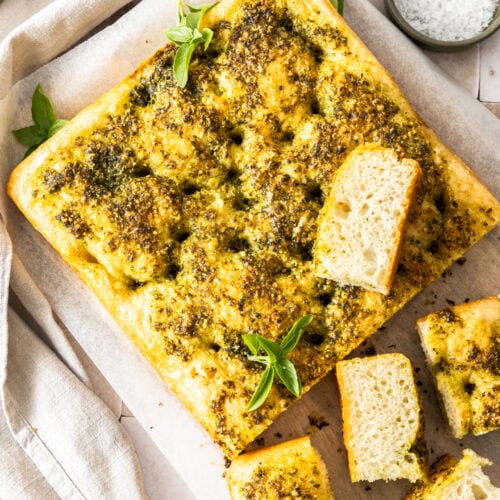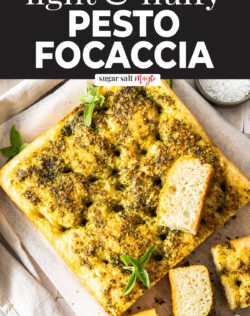Why it’s so good!
Pesto focaccia – it tastes incredible and it’s very easy to make. You’ll love this homemade focaccia bread recipe, this one topped with pesto and parmesan. It has a golden crispy crust on the top and bottom and the inside is so perfectly soft yet chewy, just as it should be. And the flavour, amazing!
Yes, it’s delicious like this but it’s also a really versatile and easy no knead focaccia recipe. Don’t like pesto? Ok, more for me but you can top it with anything really. The easy dough is a great base for any flavours you like.
This pesto focaccia version uses a basil pesto. I love to use my own basil pesto recipe because the flavour is worlds above store-bought but, hey if you want to save 5 minutes (literally) or know one you love already, you can use that. Try mine just once though and you’ll be hooked, promise!
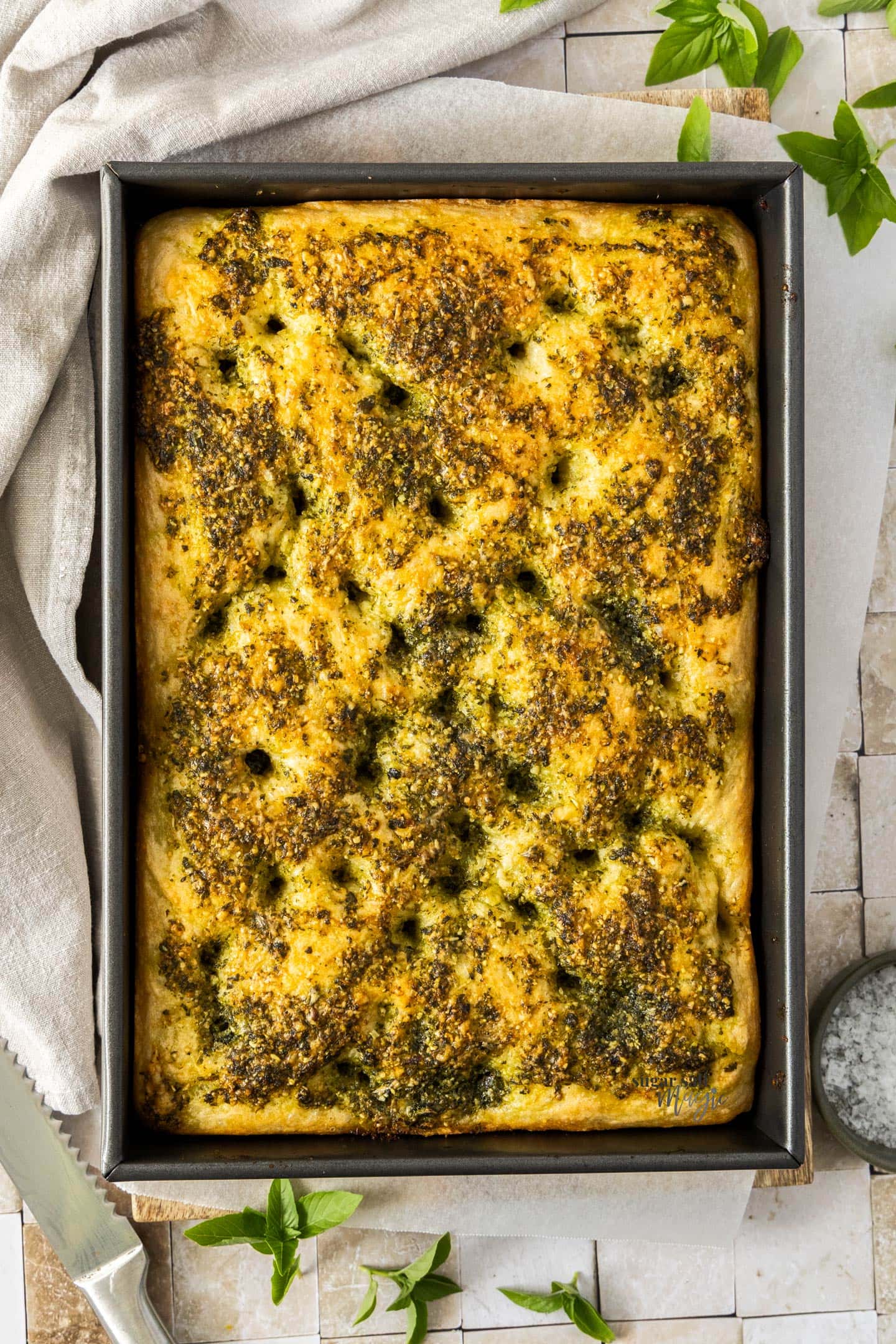
Never Miss a Recipe!
Get the latest recipes straight to your inbox!
Ingredients
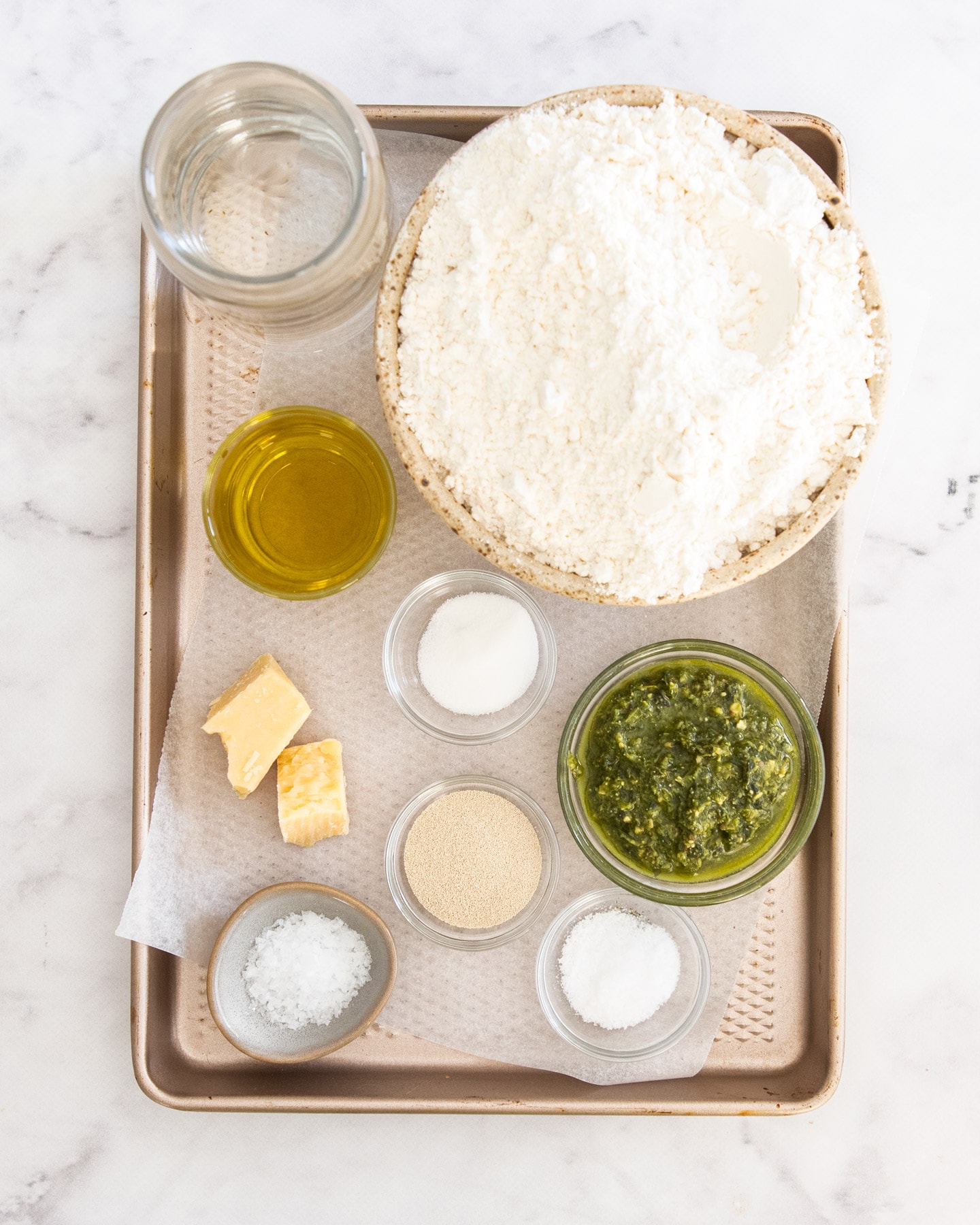
Jump to the recipe for full ingredients and instructions.
- Bread flour: You really must use bread flour here. While plain flour (all-purpose flour) will still result in bread, it won’t have the chewiness that bread should have (as opposed to the soft crumb of a cake). Bread flour has a higher protein content perfect for the texture of bread.
- Yeast: I use instant yeast / instant dry yeast. You can also use active dry yeast here but you’ll need to activate it first by mixing just the warm water, sugar and yeast then letting it sit for 10 minutes to “bloom” or puff up. Once that’s done you can proceed as per the recipe adding all the other ingredients straight into the yeast mixture.
- Sugar: While not absolutely necessary, the sugar does help the yeast to bloom and work more easily.
- Salt: Salt adds flavour to the bread. Just make sure when you add it you don’t put it directly onto the yeast as it can essentially kill the yeast this way. I also like some flaky sea salt over the top of the focaccia bread.
- Extra virgin olive oil: Use a good quality olive oil here. This adds loads of crispness to the outside of the bread.
- Pesto: You can’t have pesto focaccia without pesto. I can guarantee a delicious result if you make the pesto from scratch using this recipe but store-bought works in a bind. Make it if you can though – it takes just minutes and tastes incredible.
- Parmesan: While optional, just a little parmesan cheese adds a little umami and more deliciousness to your pesto focaccia bread.
How to make focaccia bread
This Italian bread is loved for it’s airy and chewy texture and lovely flavour. It’s great for sandwiches and freezes well and this easy no knead focaccia is so very simple to make.
Equipment-wise, you just need a large mixing bowl and a 9×13 inch / 23x33cm deep baking pan. You can use a glass or ceramic baking dish but the metal pan does give the most crispy crust.
Jump to the recipe for full ingredients and instructions.
1. Mix the focaccia dough
Start by simply mixing the dough ingredients in a large bowl until they’re combined into just a shaggy dough. There’s no need to knead it until smooth like a regular bread recipe, just stir it all together.
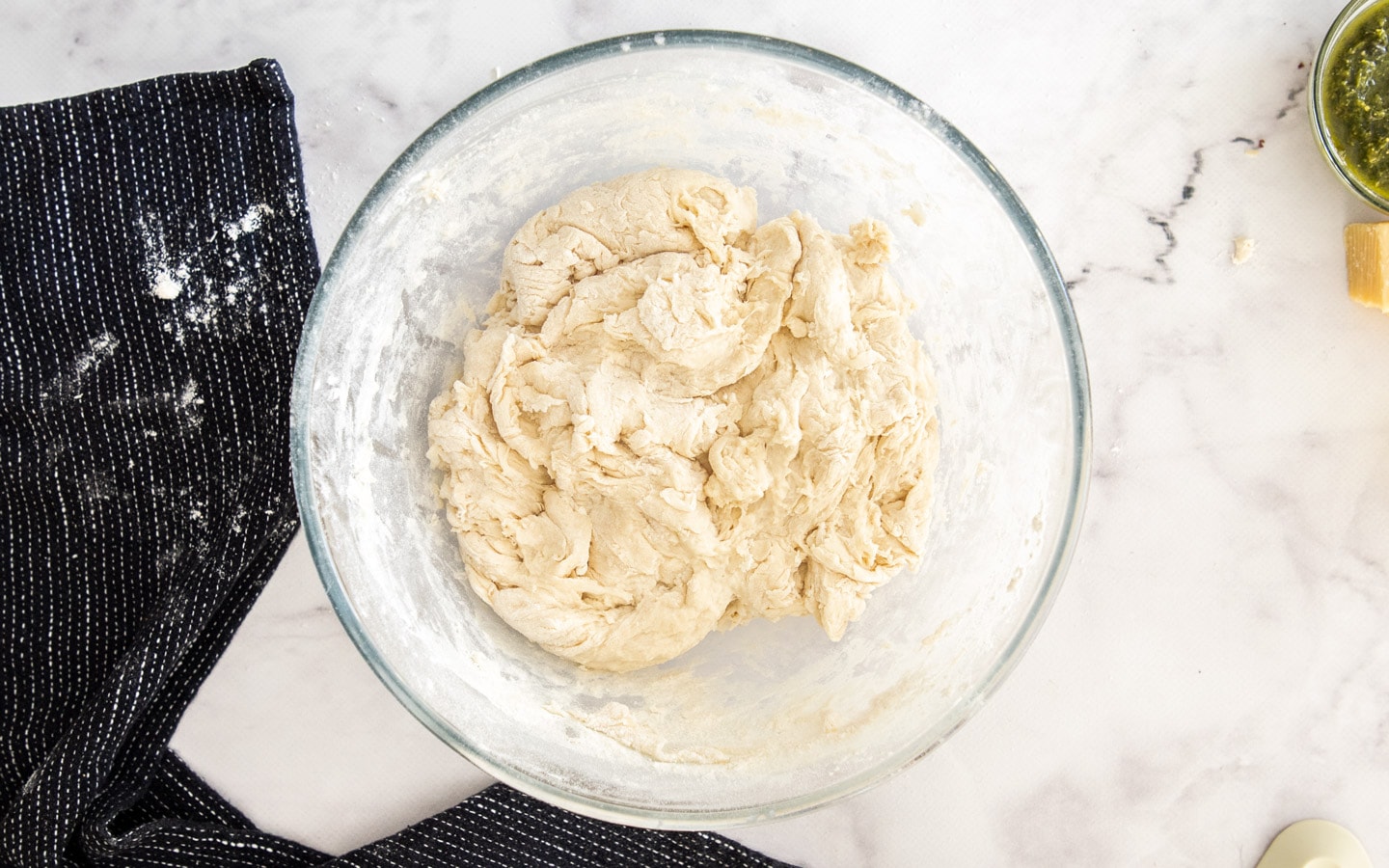
2. Prove #1 and stretch and folds
The dough needs to rise for 1 hour and 15 minutes all told and every 15 minutes for the first hour, you need to stretch and fold the dough. Imagine your dough having 4 “sides”. Lift underneath one side and pull it up and over the top gently, turn the bowl 90° and repeat. Turn, repeat, turn repeat. Now do that process 2 more times. That’s one batch of stretch and folds. The dough will be sticky and will sometimes tear, that’s fine.
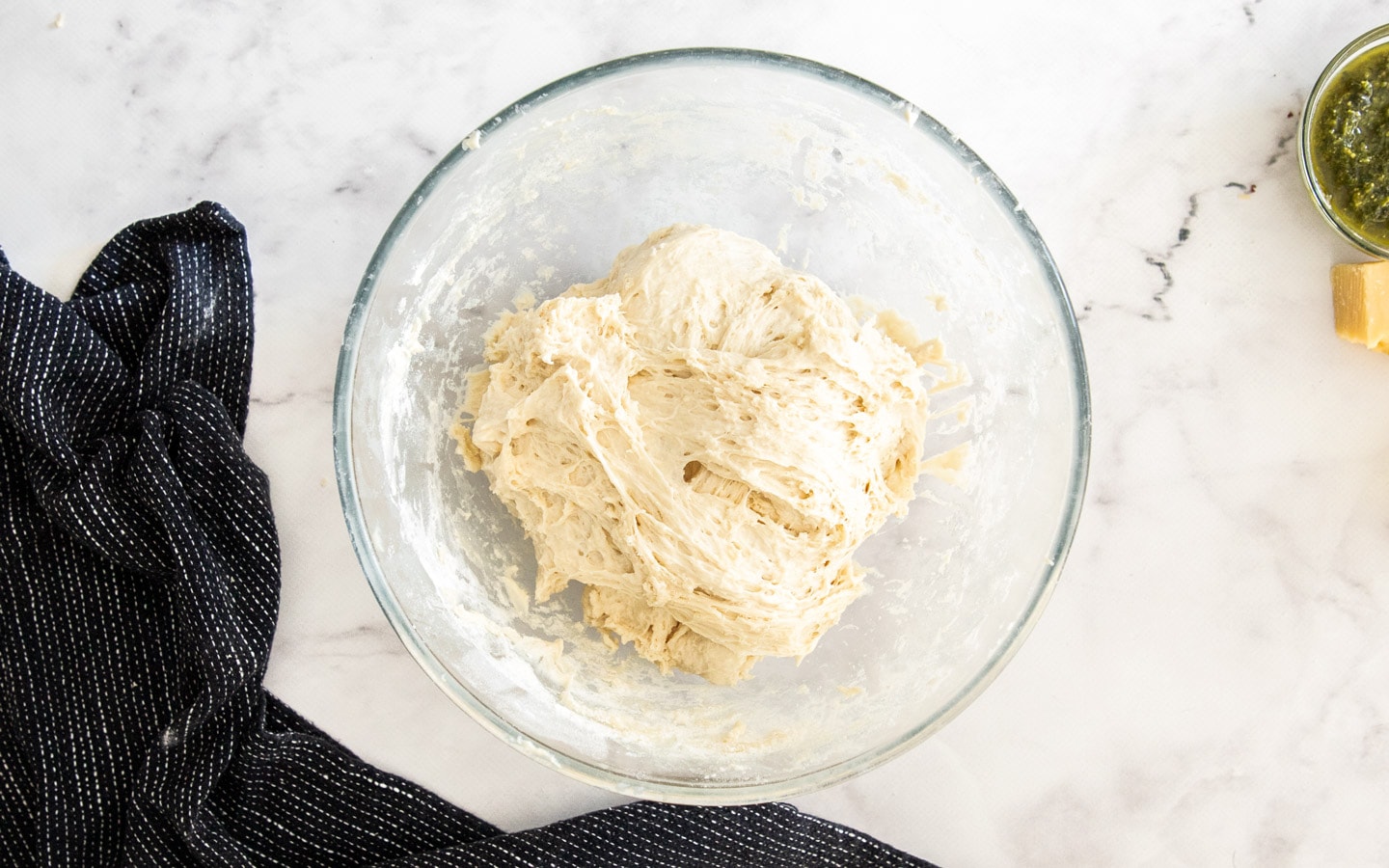
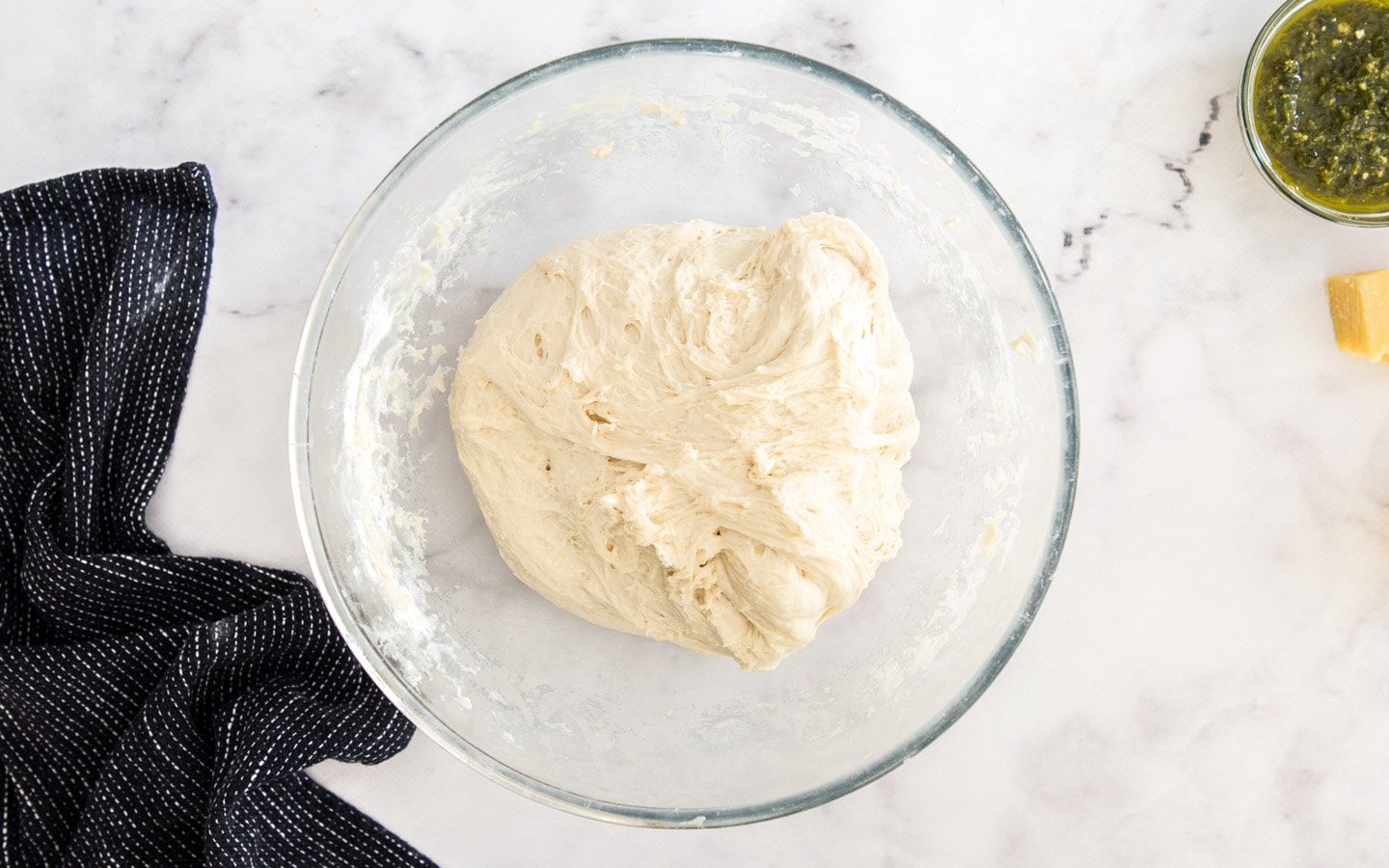
After each stretch and fold, cover the dough again and leave it in warm spot. After the last stretch and fold (below) let it sit a final 15 minutes to get all puffy again.
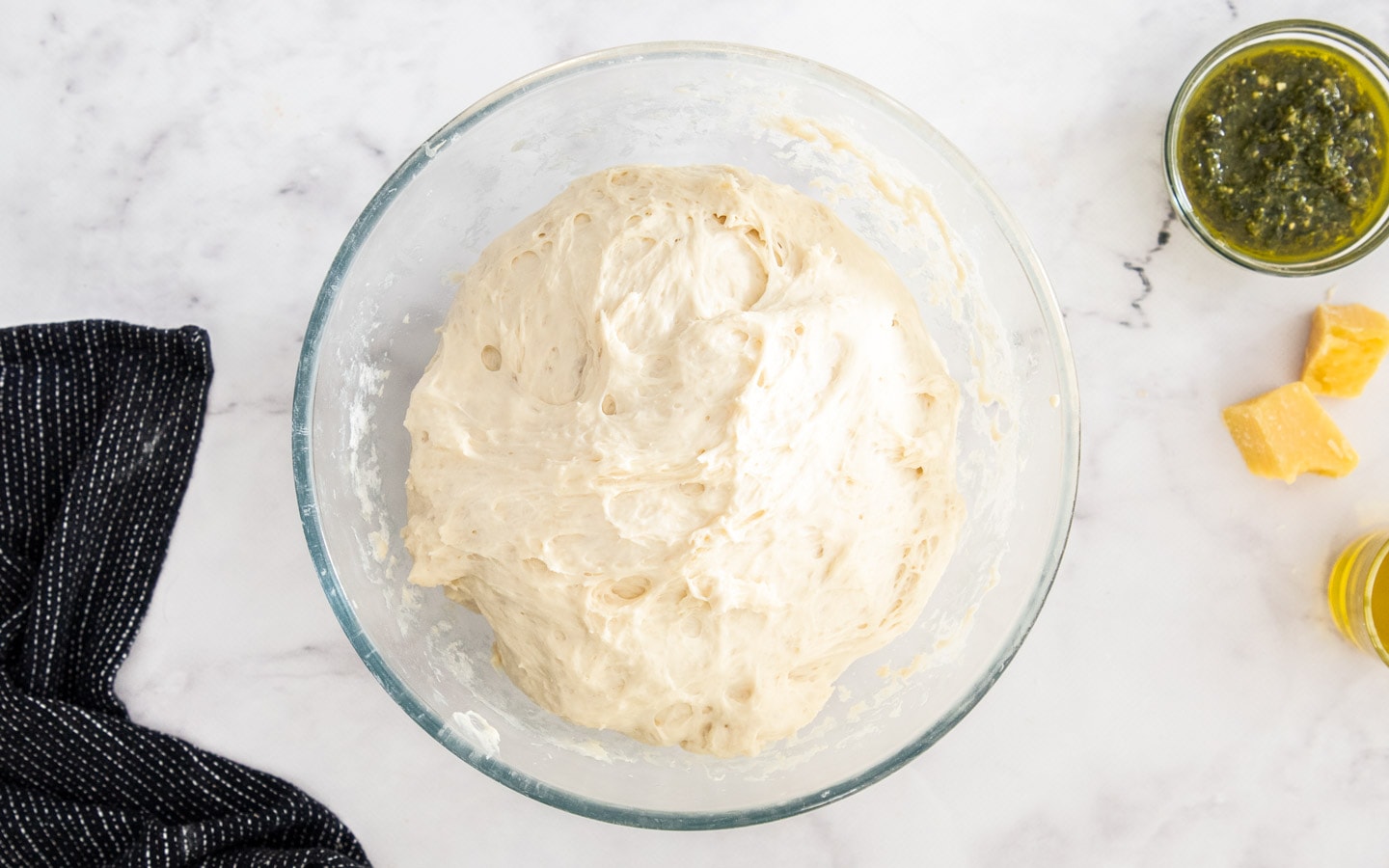
3. Shaping and second proof
After the stretch and folds and once the dough is doubled again, push and gently stretch it out into a greased, deep 9×13 inch baking pan (23x33cm) until it’s almost into the corners. Cover it again and let it rise in a warm spot until it’s doubled in size, puffy, bubbly and jiggly.
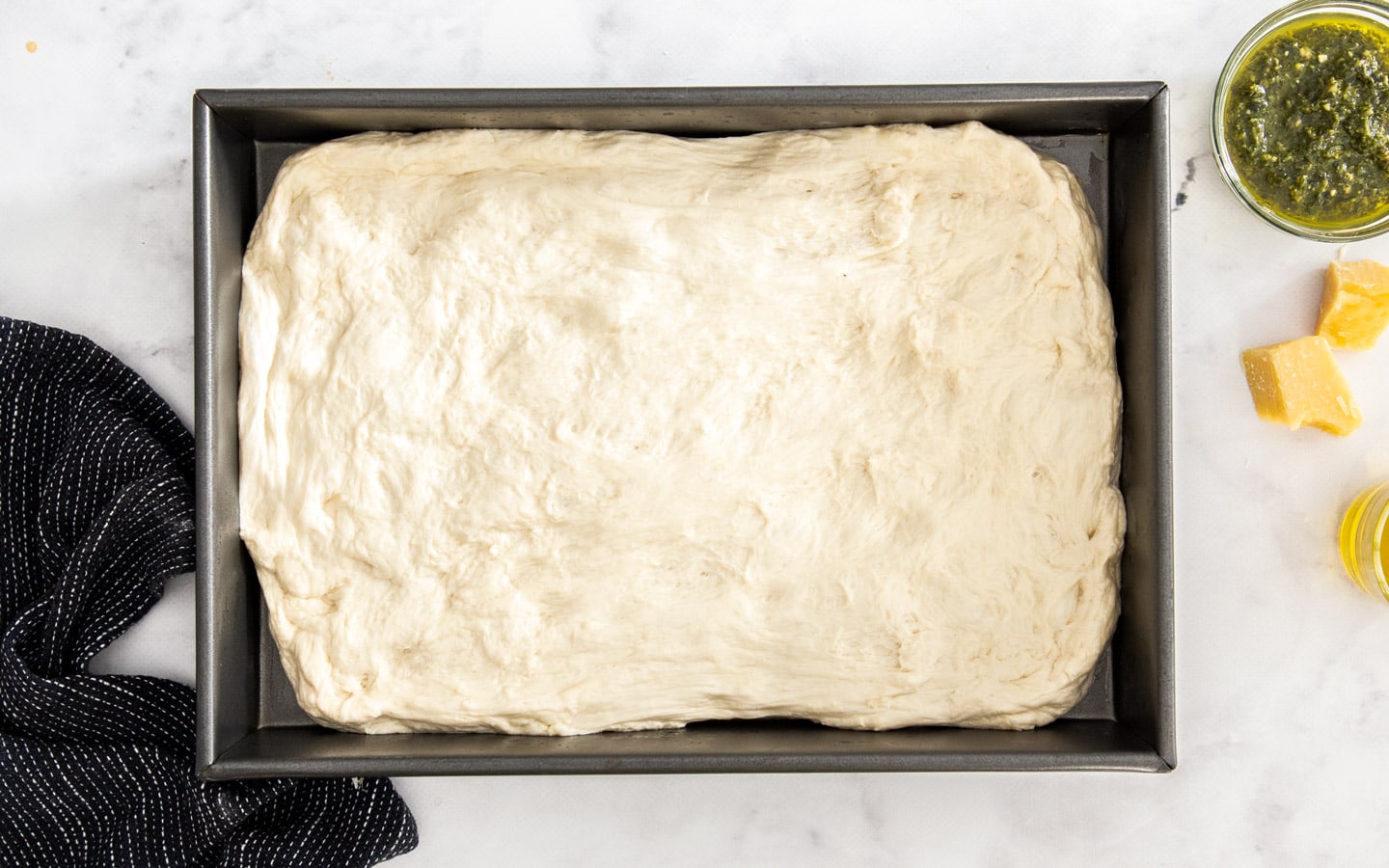
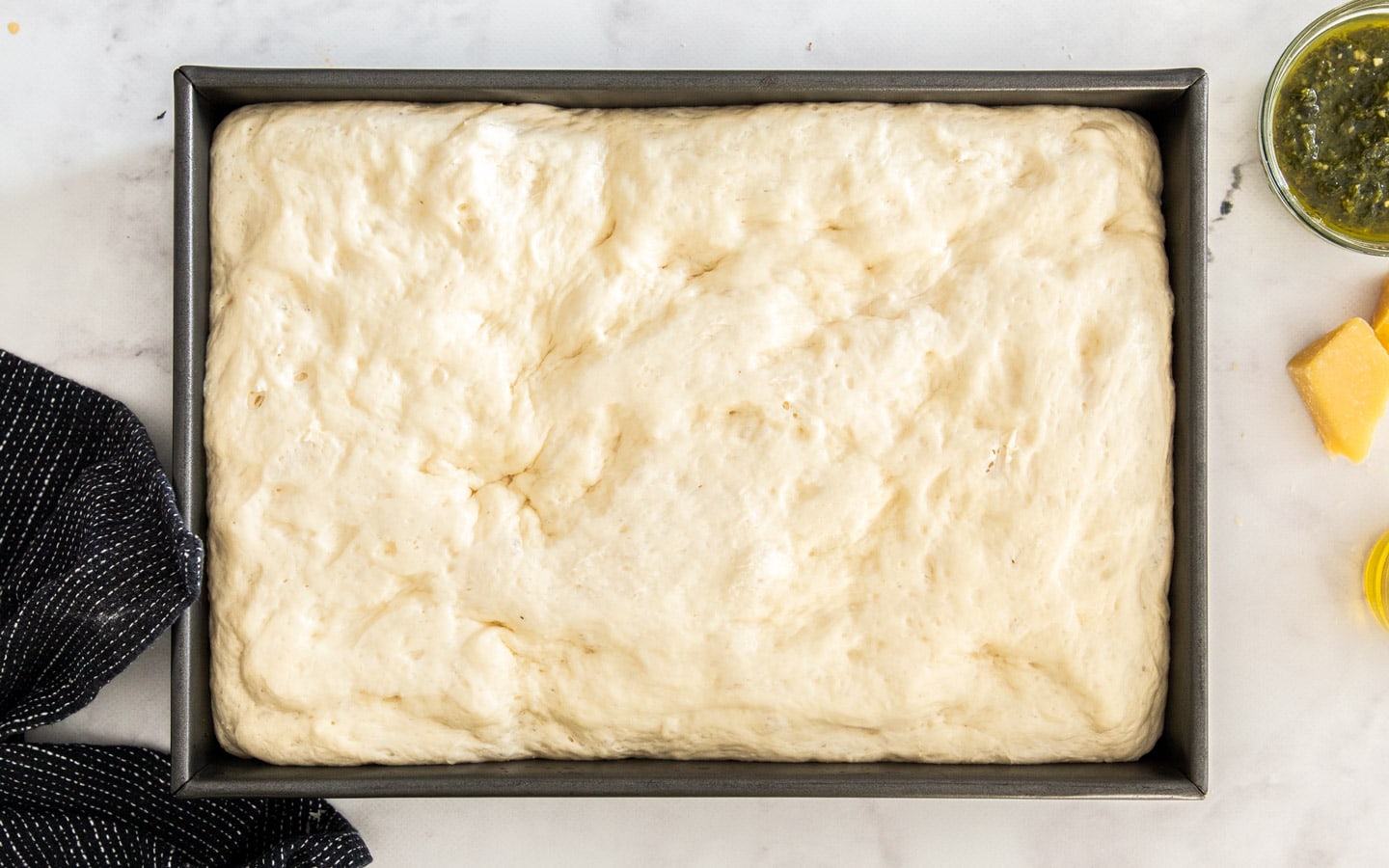
4. Add the toppings
Drizzle over the olive oil and gently spread it out with your hands. Repeat this with the pesto. Now sprinle over the parmesan and a couple of pinches of flaky sea salt.
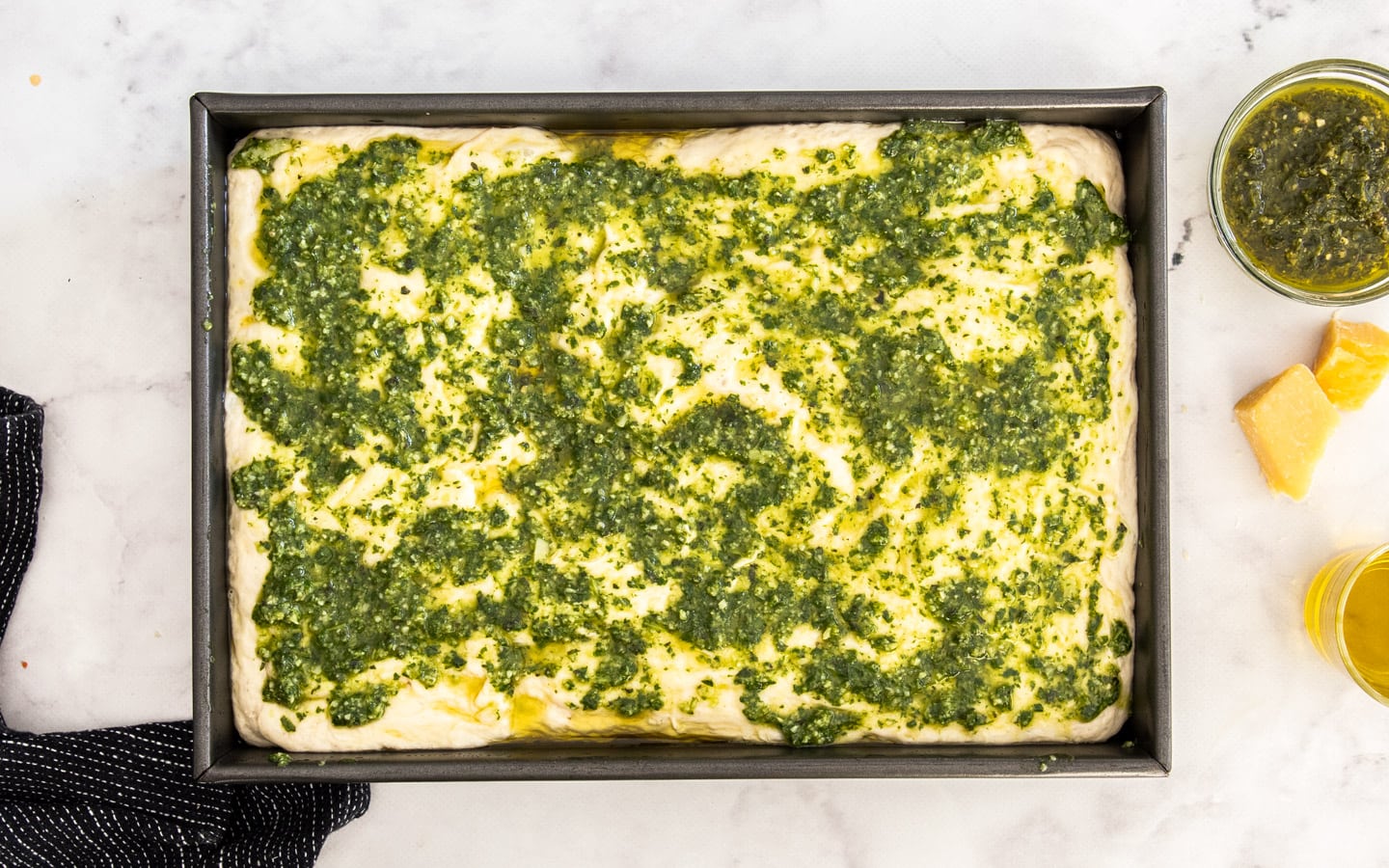
5. Dimple and bake
Such a classic technique for focaccia bread is the dimpling the top. This provides the classic look that focaccia has but it also expels some excess air, keeping the focaccia a flat loaf rather than a loaf that puffs right up. Don’t go too wild, just use both hands pressing in about 4 times. Baking the pesto focaccia bread at a relatively high heat means you get a crispy golden crust.
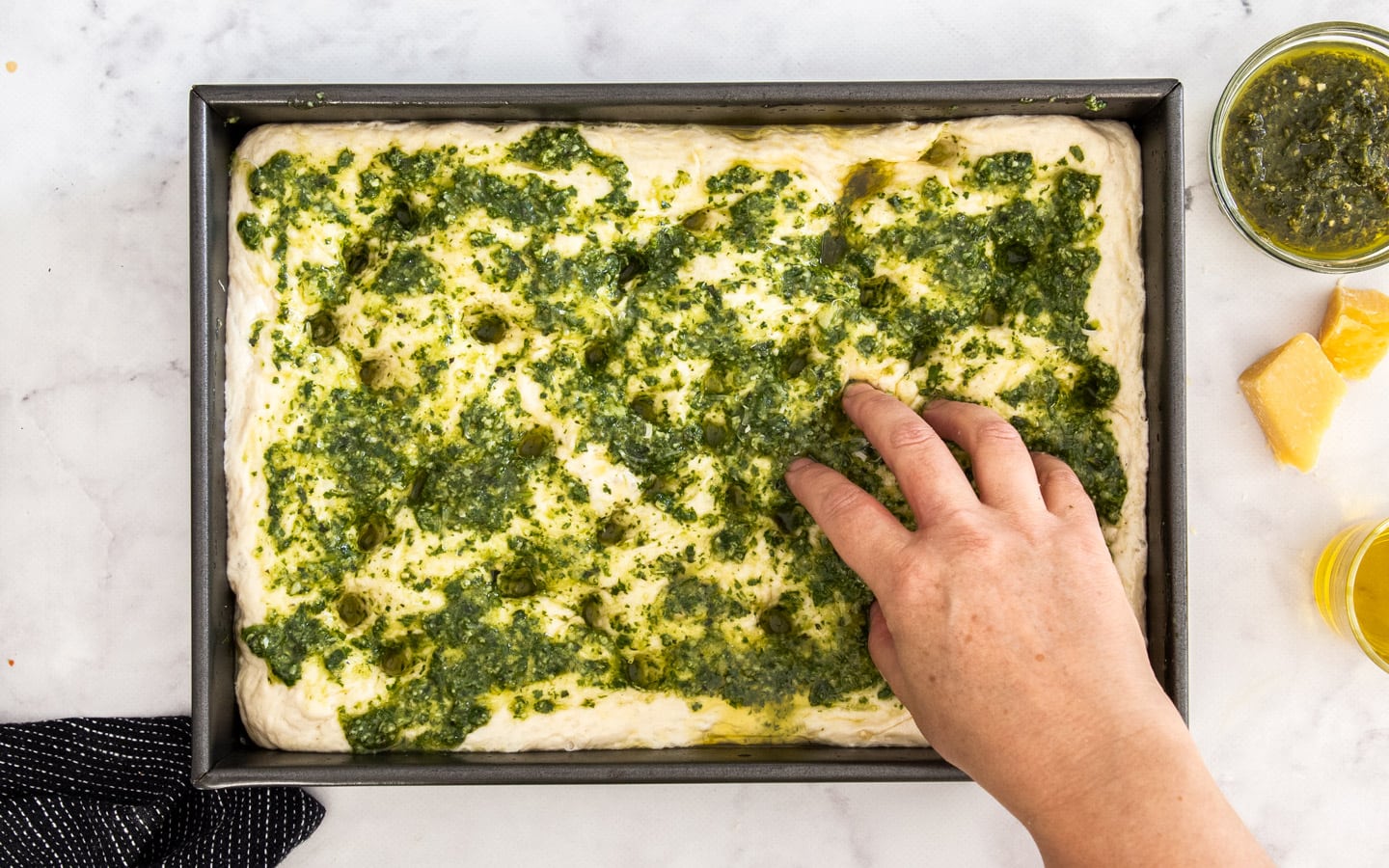
Can I refrigerate the dough overnight?
Once the dough ingredients are mixed, but before shaping, you can actually cover and chill the pesto focaccia dough in the fridge overnight or up to 72 hours. This extended fermentation time tends to add more complexity to the flavour of the dough and also improve the distribution of the air bubbles. In the image below, the top dough was chilled for about 40 hours while the bottom dough was made and baked on the same day.
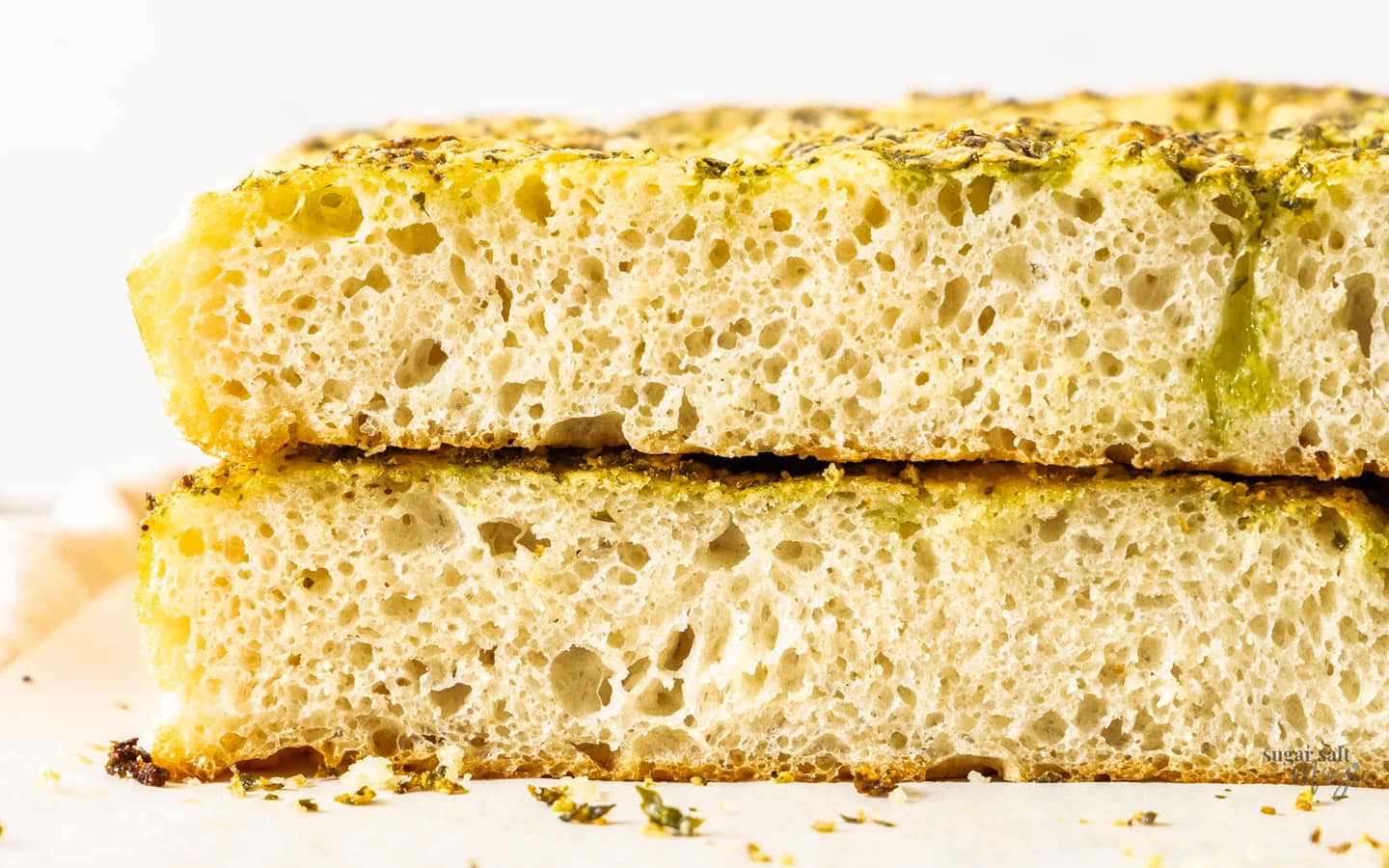
Personally, I don’t think it needs the extra time – it doesn’t add enough extra flavour or air bubbles to make it a necessity but it’s a useful tip if you don’t want to make it all in one day. The other bonus with this method is the stretch and folds aren’t required. Just take the dough out of the fridge and immediately shape it into the pan. Let it sit in a warm place for an hour, then proceed with topping and baking.
The stretch and fold technique
Using this stretch and fold technique for this pesto focaccia recipes serves two purposes.
First, you don’t need to knead the dough. Kneading dough creates gluten which is important in bread making but by using the stretch and fold technique you’re creating the gluten without the arm workout.
Secondly, it creates air bubbles. Focaccia is known for having larger air bubbles than your classic white bread loaf. By lifting and folding the dough over itself (a total of 12 times in this recipe) you’re creating those wonderful bubbles.
It’s a high moisture dough
It’s important to keep in mind, the dough will be sticky – it’s a high moisture loaf which is important for texture and for the air bubbles. That moisture creates steam which in turn creates little pockets of air as the dough bakes. The dough will be stickier at the start than it is on the last fold.
The dough might tear – that’s ok.
Also, it might tear sometimes. That’s ok but just be gentle with it. It will tear because it hasn’t been kneaded which creates long gluten strands which in turn create elasticity in dough.
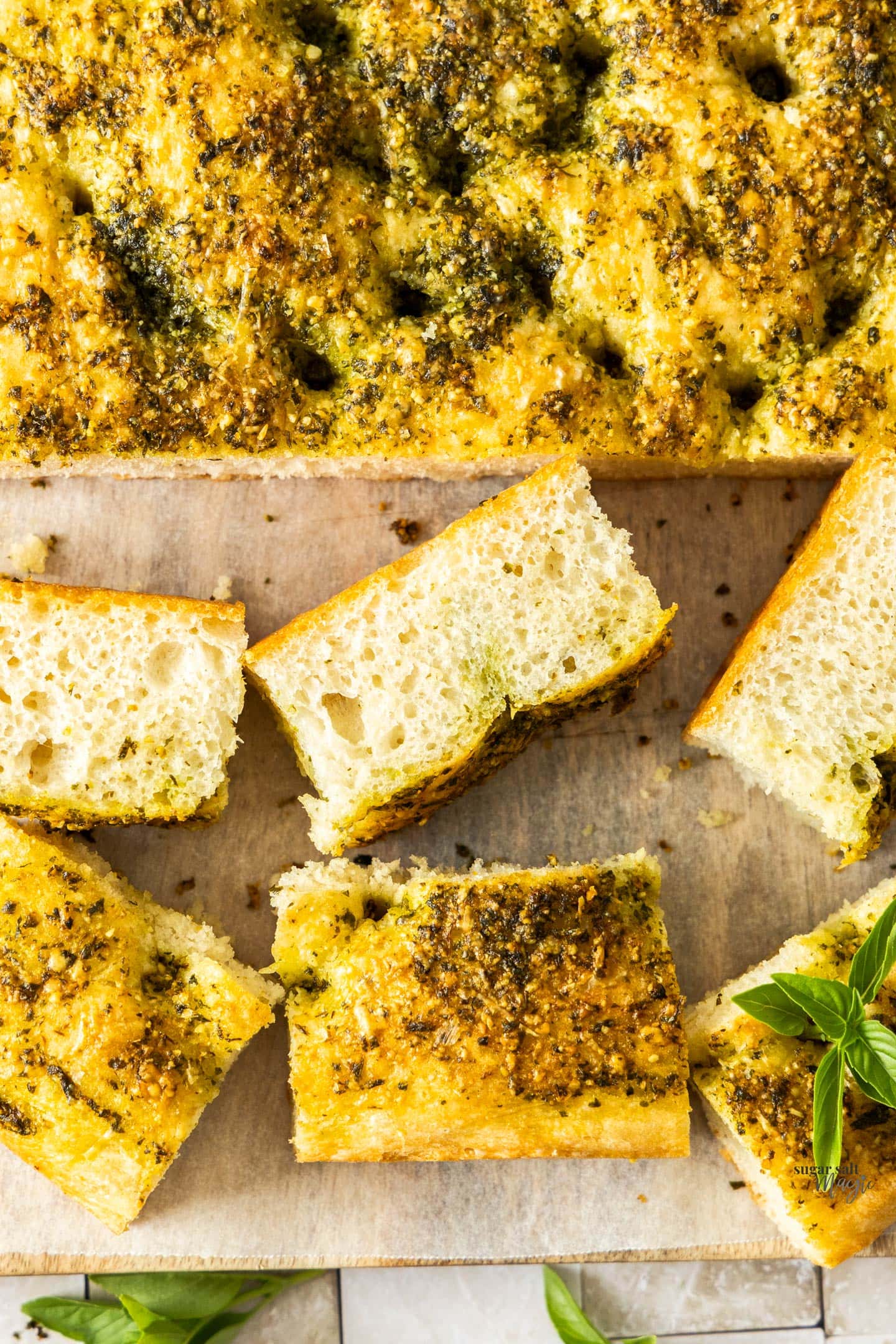
Focaccia topping ideas
I encourage you to first try this pesto focaccia recipe but once you have, you can use this versatile focaccia dough to create loads of great flavour combinations.
Always spread the oil over the dough and the flaky sea salt is always a great way to go too. Once you’ve done that try these great topping ideas;
- The classic: Little sprigs of fresh rosemary leaves pressed into the dimples. Other herbs are lovely over this too.
- Tomato: Press halved cherry tomatoes into the dough and scatter over sliced onion.
- Olives: Halved olives pressed into the dough. Tomatoes go great with this too.
- Cheese: Press halved balls of bocconcini into the dough, maybe with some garlic rubbed over the top and some parmesan cheese sprinkled over.
- Garlic: Roast a bulb of garlic wrapped in foil until soft. Squeeze out the cloves of soft garlic and press them into the top of the dough, then scatter over some finely sliced onion and thyme leaves.
- Anchovy and tomato: Anchovies and sundried tomatoes are an absolute flavour-bomb. You can also add just a couple of anchovies squished with a knife until spreadable. I’ve done that with this pesto focaccia and they add a saltiness and umami without tasting like whole anchovies.
- Go Greek: Try some cubes of feta, onion and strips of roasted peppers over the top.
What flavours would you try?
Storage
Store leftover pesto focaccia in an airtight container at room temperature for 3-4 days. It also freezes well. Freeze it in portions in an airtight container or in a ziplock bag so you can take just what you need.
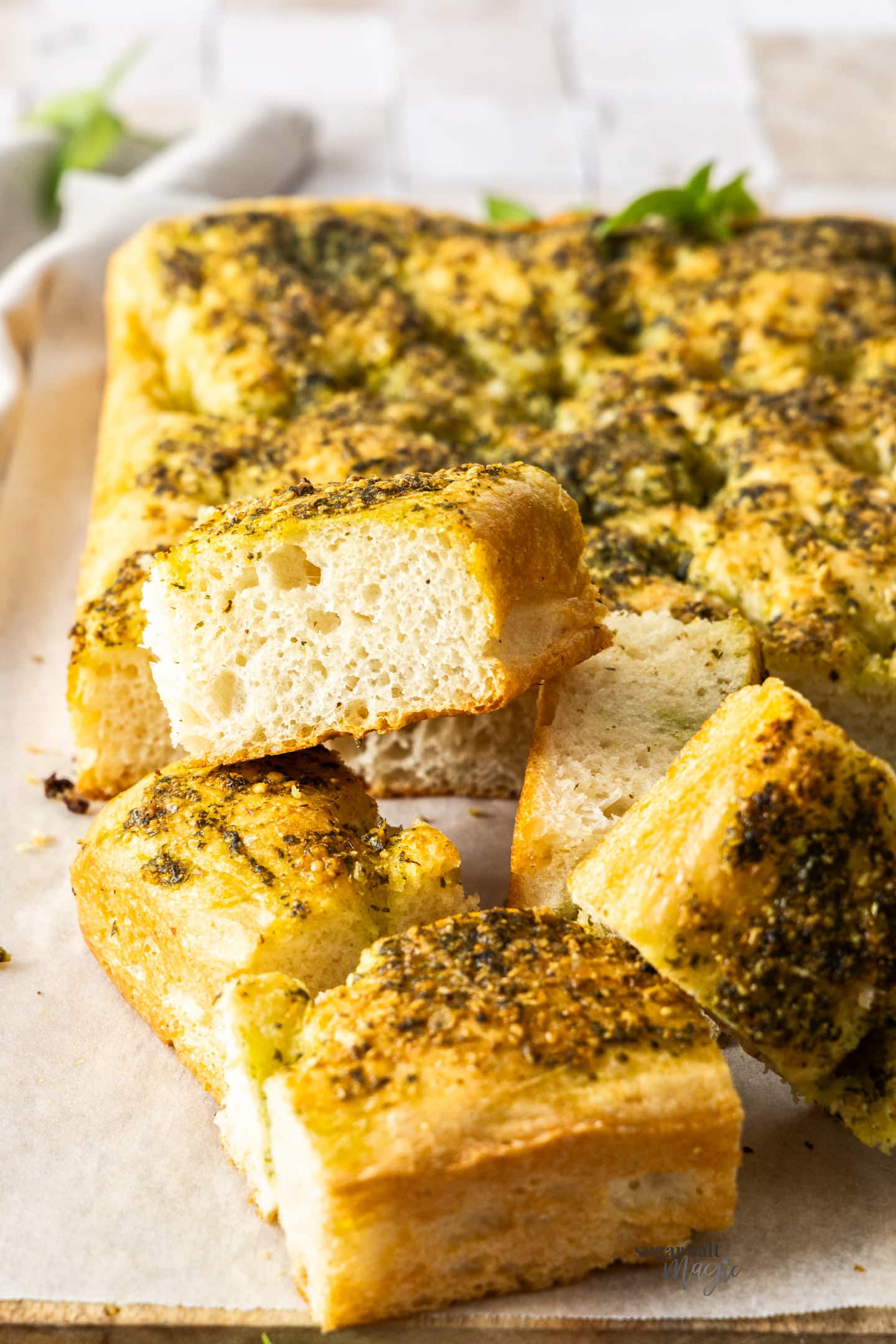
⭐⭐⭐⭐⭐
Did you try this pesto focaccia recipe? Show it some love in the comments below.
Hungry for more? Subscribe to the newsletter for free recipes straight to your inbox. Also, follow along on Facebook, Pinterest and Instagram.
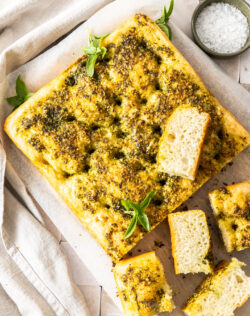
Ingredients
- 585 g bread flour (4 ½ cups, spooned and levelled)
- 2 ¼ teaspoons instant yeast
- 1 teaspoon sugar (or honey)
- 1 teaspoon cooking salt / kosher salt
- 2 cups warm water (500ml)
TOPPINGS
- 2 tablespoons olive oil (plus more for greasing)
- ⅓ cup basil pesto
- 1 tablespoon finely shredded parmesan
- Flaky sea salt
For best results, always weigh ingredients where a weight is provided
Equipment
- Large mixing bowl
- Deep 9×13 inch pan (23x33cm)
Instructions
- Combine the flour, yeast, sugar, salt (tot the side of the bowl) and water. Mix well with a spatula until you have a combined but shaggy dough.
- OPTIONAL REFRIGERATED FERMENTATION:At this point, you can (optional) just cover the dough and chill overnight or up to 72 hours. This slow fermentation adds more complexity to the flavour and gives the air bubbles more even distribution. If you use this method, you can also skip the stretch and folds and just skip to the 2nd rise step.
- FIRST RISE & STRETCH AND FOLDS (see notes too): Cover the bowl with plastic wrap for 1 hour and leave in a warm spot, doing a stretch and fold every 15 minutes. To stretch and fold, first imagine 4 sides to your dough (like north, south, east, west). Starting at north, lift the dough from underneath and fold it over the top of the dough. Turn the bowl 90° and do the same, then repeat that two more times. The dough will feel tougher the 2nd and 3rd times.Now, repeat that stretch and fold on the 4 sides 3 more times. Repeat this 3 sets of 4 stretch and folds every 15 minutes.
- After the final stretch and fold, cover and let the dough sit for a final 15 minutes – it should puff up nicely to double it's initial size. In total the dough would have sat for 1 hour and 15 minutes with stretch and folds 4 times.
- Preheat the oven to 220C (200C fan forced) / 425F.
- Add a little drizzle of oil to a deep 23x33cm /9×13 inch baking pan. Rub it around all over the base and sides.
- 2ND RISE:Spread the dough into the prepared pan gently stretching it out to the corners. You can push and prod it, and lift it allowing it's weight to stretch it downwards etc and keep doing this until you have it almost right into the corners. Cover with plastic wrap and prove another 45-60 minutes in a warm spot until it looks thick, puffy, bubbly and jiggles when you shake the pan.
- Don't punch down the dough. Drizzle the top of the focaccia dough with the 2 tablespoons of olive oil and gently spread it all over the top with your hands.
- Dollop over pesto mixture. Spread with your hands again. Sprinkle over the parmesan and a good couple of pinches of flaky sea salt.
- Now, press the fingertips of both hands into the dough to dimple it all over.
- Bake for 23-26 minutes until the top and base are golden brown and crisp.
- Please take a moment to leave a comment & rating. It's appreciated and so helpful.
Notes
- Tablespoons: I use a standard Australian 20ml tablespoon (equal to 4 teaspoons). Check yours before measuring.
- Stretch and folds. This is a great way to get air into the dough so that you get nice air bubbles in the focaccia bread. The first two or three sets of stretch and folds, the dough might tear as you do this because it’s a no knead dough – it hasn’t worked up any gluten. Don’t worry, just keep going. By the last one it will be a little smoother and little less likely to tear. Also, the dough will be sticky to begin with and become less sticky as the stretch and folds go on.
- Nutrition details are approximate only – scroll below the recipe to find the full nutritional information.
This post may contain affiliate links that earn me a small commission for my referral, at no extra cost to you. Thank you for supporting Sugar Salt Magic.

